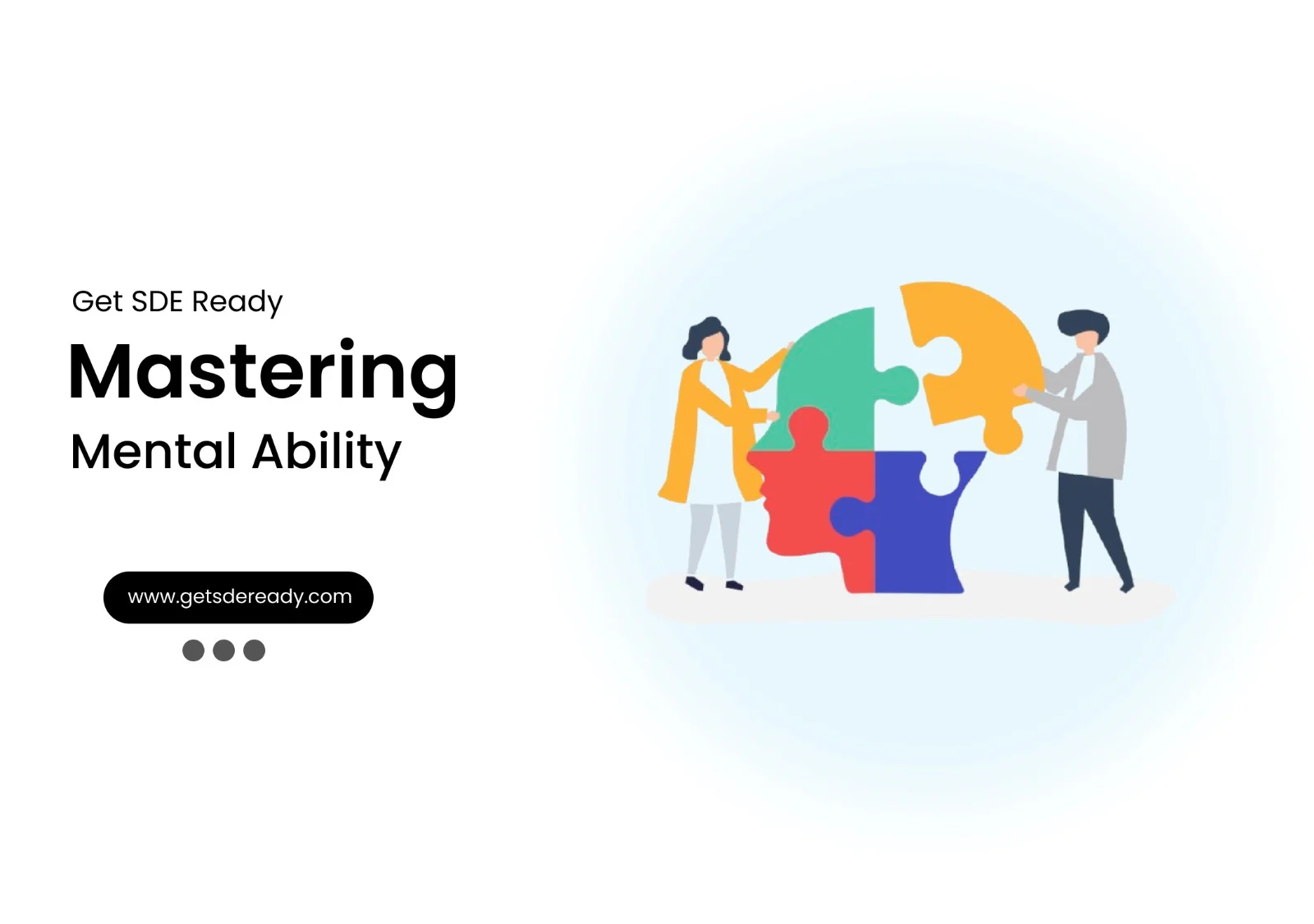Data Structures and Algorithms
- Introduction to Data Structures and Algorithms
- Time and Space Complexity Analysis
- Big-O, Big-Theta, and Big-Omega Notations
- Recursion and Backtracking
- Divide and Conquer Algorithm
- Dynamic Programming: Memoization vs. Tabulation
- Greedy Algorithms and Their Use Cases
- Understanding Arrays: Types and Operations
- Linear Search vs. Binary Search
- Sorting Algorithms: Bubble, Insertion, Selection, and Merge Sort
- QuickSort: Explanation and Implementation
- Heap Sort and Its Applications
- Counting Sort, Radix Sort, and Bucket Sort
- Hashing Techniques: Hash Tables and Collisions
- Open Addressing vs. Separate Chaining in Hashing
- DSA Questions for Beginners
- Advanced DSA Questions for Competitive Programming
- Top 10 DSA Questions to Crack Your Next Coding Test
- Top 50 DSA Questions Every Programmer Should Practice
- Top Atlassian DSA Interview Questions
- Top Amazon DSA Interview Questions
- Top Microsoft DSA Interview Questions
- Top Meta (Facebook) DSA Interview Questions
- Netflix DSA Interview Questions and Preparation Guide
- Top 20 DSA Interview Questions You Need to Know
- Top Uber DSA Interview Questions and Solutions
- Google DSA Interview Questions and How to Prepare
- Airbnb DSA Interview Questions and How to Solve Them
- Mobile App DSA Interview Questions and Solutions
DSA Interview Questions
- DSA Questions for Beginners
- Advanced DSA Questions for Competitive Programming
- Top 10 DSA Questions to Crack Your Next Coding Test
- Top 50 DSA Questions Every Programmer Should Practice
- Top Atlassian DSA Interview Questions
- Top Amazon DSA Interview Questions
- Top Microsoft DSA Interview Questions
- Top Meta (Facebook) DSA Interview Questions
- Netflix DSA Interview Questions and Preparation Guide
- Top 20 DSA Interview Questions You Need to Know
- Top Uber DSA Interview Questions and Solutions
- Google DSA Interview Questions and How to Prepare
- Airbnb DSA Interview Questions and How to Solve Them
- Mobile App DSA Interview Questions and Solutions
Data Structures and Algorithms
- Introduction to Data Structures and Algorithms
- Time and Space Complexity Analysis
- Big-O, Big-Theta, and Big-Omega Notations
- Recursion and Backtracking
- Divide and Conquer Algorithm
- Dynamic Programming: Memoization vs. Tabulation
- Greedy Algorithms and Their Use Cases
- Understanding Arrays: Types and Operations
- Linear Search vs. Binary Search
- Sorting Algorithms: Bubble, Insertion, Selection, and Merge Sort
- QuickSort: Explanation and Implementation
- Heap Sort and Its Applications
- Counting Sort, Radix Sort, and Bucket Sort
- Hashing Techniques: Hash Tables and Collisions
- Open Addressing vs. Separate Chaining in Hashing
- DSA Questions for Beginners
- Advanced DSA Questions for Competitive Programming
- Top 10 DSA Questions to Crack Your Next Coding Test
- Top 50 DSA Questions Every Programmer Should Practice
- Top Atlassian DSA Interview Questions
- Top Amazon DSA Interview Questions
- Top Microsoft DSA Interview Questions
- Top Meta (Facebook) DSA Interview Questions
- Netflix DSA Interview Questions and Preparation Guide
- Top 20 DSA Interview Questions You Need to Know
- Top Uber DSA Interview Questions and Solutions
- Google DSA Interview Questions and How to Prepare
- Airbnb DSA Interview Questions and How to Solve Them
- Mobile App DSA Interview Questions and Solutions
DSA Interview Questions
- DSA Questions for Beginners
- Advanced DSA Questions for Competitive Programming
- Top 10 DSA Questions to Crack Your Next Coding Test
- Top 50 DSA Questions Every Programmer Should Practice
- Top Atlassian DSA Interview Questions
- Top Amazon DSA Interview Questions
- Top Microsoft DSA Interview Questions
- Top Meta (Facebook) DSA Interview Questions
- Netflix DSA Interview Questions and Preparation Guide
- Top 20 DSA Interview Questions You Need to Know
- Top Uber DSA Interview Questions and Solutions
- Google DSA Interview Questions and How to Prepare
- Airbnb DSA Interview Questions and How to Solve Them
- Mobile App DSA Interview Questions and Solutions
API Gateway vs Load Balancer: What’s the Difference?
Have you ever wondered how modern applications handle massive traffic while keeping everything secure and efficient? In the world of system design, API gateways and load balancers are two powerhouse tools that often get confused, but they play distinct roles in keeping your backend running smoothly. Whether you’re building a microservices architecture or scaling a web app, understanding their differences can save you headaches down the road. If you’re eager to dive deeper into these concepts and get hands-on with free resources, sign up for our latest course updates to unlock expert tips and tutorials straight to your inbox.
Understanding API Gateways
Let’s start by breaking down what an API gateway really is. Imagine it as the front door to your application’s services—controlling who gets in, how they interact, and even translating languages between different parts of your system.
What is an API Gateway?
An API gateway acts as a single entry point for client requests in a microservices-based architecture. It sits between the client (like a mobile app or web browser) and the backend services, managing and routing API calls efficiently. According to industry experts at Kong HQ, it’s essentially a “server that acts as an intermediary between clients and backend services,” handling everything from request routing to security enforcement.
In practice, API gateways simplify complex interactions. For instance, if a user app needs data from multiple microservices (like user profiles, payments, and recommendations), the gateway aggregates those responses into one cohesive reply, reducing the number of calls the client has to make.
Key Features of API Gateways
API gateways come packed with features that make them indispensable for API management:
- Routing and Request Transformation: Routes requests to the right backend service and can transform data formats (e.g., converting JSON to XML) or protocols (e.g., HTTP to gRPC).
- Security Controls: Handles authentication (OAuth, JWT), authorization, and encryption to protect against unauthorized access. Rate limiting and throttling prevent abuse, like DDoS attacks.
- Caching and Performance Optimization: Stores frequently accessed data to reduce latency—think caching user session info to speed up subsequent requests.
- Monitoring and Analytics: Provides insights into API usage, error rates, and performance metrics. Tools like AWS API Gateway integrate with monitoring services for real-time dashboards.
- API Versioning and Aggregation: Supports multiple API versions simultaneously and combines responses from various services into a single output.
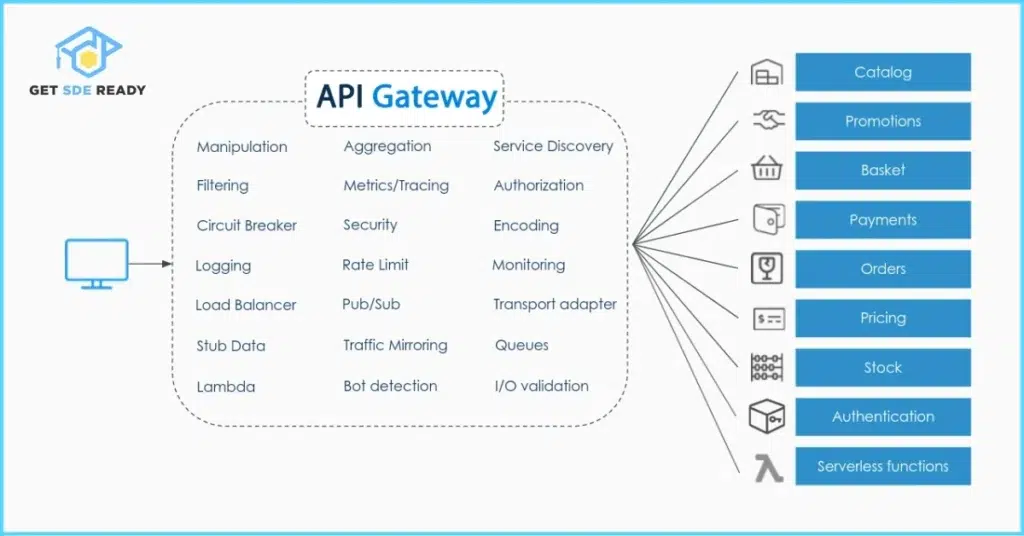
These features operate at the application layer (OSI Layer 7), allowing the gateway to inspect and modify request content intelligently.
Pros and Cons of API Gateways
Like any tool, API gateways have their strengths and trade-offs:
- Pros:
- Centralized management simplifies security and updates across microservices.
- Enhances scalability by distributing requests and enabling protocol translation.
- Improves developer productivity—for example, clients interact with one endpoint instead of dozens.
- Boosts performance through caching; studies from Tyk show gateways can reduce backend load by up to 50% with effective caching.
- Cons:
- Introduces potential latency due to additional processing layers.
- Can become a single point of failure if not configured with redundancy (e.g., multiple gateway instances).
- Higher complexity and cost for setup, especially in large-scale deployments.
In a 2025 survey by Gartner, 78% of enterprises reported using API gateways for microservices security, highlighting their growing adoption.
Understanding Load Balancers
Now, shift gears to load balancers—the traffic cops of your infrastructure, ensuring no server gets overwhelmed while keeping everything flowing smoothly.
What is a Load Balancer?
A load balancer distributes incoming network traffic across multiple backend servers to optimize resource use, maximize throughput, and ensure high availability. As explained by Solo.io, it “sits between the servers handling user requests and the public Internet,” dynamically routing requests to healthy servers based on algorithms like round-robin or least connections.
There are hardware-based load balancers (physical devices) and software-based ones (virtual or cloud-managed, like AWS Elastic Load Balancing). They can operate at Layer 4 (transport layer, handling TCP/UDP) or Layer 7 (application layer, for more intelligent routing).
Key Features of Load Balancers
Load balancers excel at raw traffic management:
- Traffic Distribution Algorithms: Round-robin for even distribution, least connections for sending requests to the least busy server, or IP hashing for geographic optimization.
- Health Checks and Failover: Continuously monitors server health and reroutes traffic if a server fails, ensuring 99.99% uptime in many cases.
- SSL/TLS Termination: Offloads encryption/decryption from backend servers, reducing their computational load.
- Session Persistence: Maintains “sticky sessions” so users stay connected to the same server for stateful applications.
- Scalability Support: Integrates with auto-scaling groups to add/remove servers based on demand.
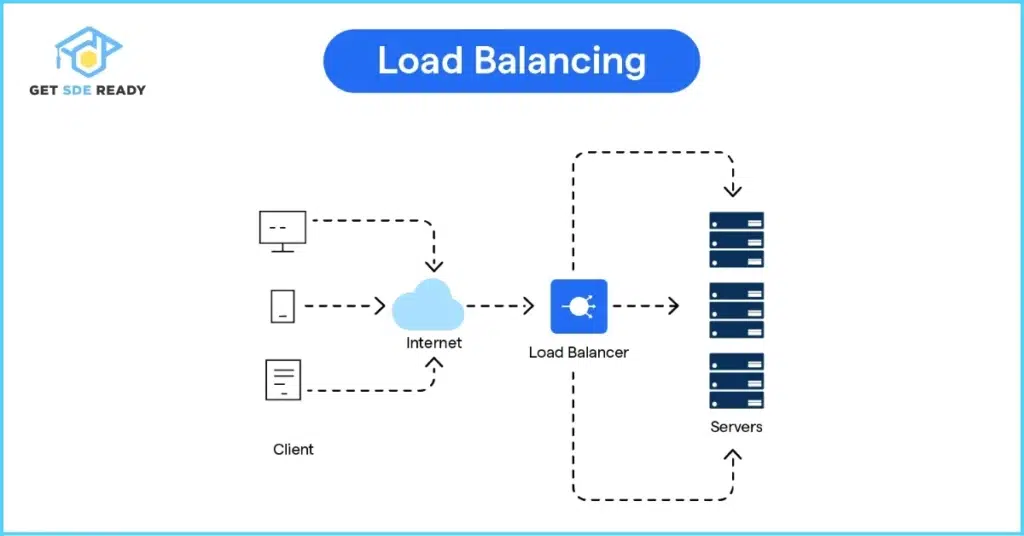
Real-world data from AWS shows that load balancers can handle billions of requests per day, with automatic scaling during traffic spikes.
Pros and Cons of Load Balancers
Here’s a balanced view:
- Pros:
- Ensures high availability—redirects traffic during failures, minimizing downtime.
- Improves performance by preventing server overload; a 2025 Cloudflare report noted a 30% average reduction in response times with proper balancing.
- Cost-effective for scaling, as it allows horizontal growth without overprovisioning.
- Provides basic security like DDoS mitigation and traffic filtering.
- Cons:
- Limited to traffic distribution; lacks deep API management like authentication.
- Can introduce minor latency in complex setups.
- Hardware versions are expensive and less flexible than software alternatives.
Load balancers are a staple in 85% of cloud deployments, per a 2025 Statista survey, underscoring their reliability for high-traffic sites.
Key Differences Between API Gateways and Load Balancers
To make this crystal clear, let’s compare them side by side in a table:
Aspect | API Gateway | Load Balancer |
Primary Focus | API management, security, and routing | Traffic distribution and availability |
OSI Layer | Layer 7 (application) | Layers 4-7 (transport/application) |
Key Capabilities | Authentication, rate limiting, caching, transformation | Health checks, failover, SSL termination |
Use in Architecture | Front-end for microservices | Backend traffic distributor |
Scalability | Handles API complexity and versioning | Manages traffic volume and server load |
Security | Advanced (auth, encryption) | Basic (DDoS, filtering) |
Performance Impact | Adds processing overhead but optimizes with caching | Minimal overhead, focuses on distribution |
As HubSpot’s experts put it, “The main difference is that API gateways provide secure access to backend services, whereas load balancers distribute traffic between multiple servers.” This distinction is crucial for architects deciding where to invest.
When to Use an API Gateway vs. a Load Balancer
Choosing the right tool depends on your needs:
- Use an API Gateway When:
- You’re dealing with microservices and need centralized control.
- Security is paramount—e.g., for public-facing APIs in fintech apps.
- You require features like rate limiting or response aggregation, as in e-commerce platforms aggregating product data.
- Example: Netflix uses API gateways to manage thousands of microservices, ensuring seamless streaming for millions.
- Use a Load Balancer When:
- High availability and traffic distribution are your main concerns.
- You’re scaling monolithic or simple apps with heavy load.
- Basic routing suffices without deep API logic.
- Example: Amazon’s e-commerce site relies on Elastic Load Balancers to handle Black Friday surges, distributing traffic across global servers.
If you’re exploring system design further, our Master DSA, Web Dev, and System Design course offers practical modules on these topics.
How API Gateways and Load Balancers Work Together
The beauty is they don’t have to compete—they complement each other. In a typical setup:
- Client requests hit the API gateway first for authentication and routing.
- The gateway forwards validated requests to the load balancer.
- The load balancer distributes them across backend servers.

This layered approach, as described by Moesif, “optimizes network performance” by combining security with efficient distribution. For instance, in Kubernetes environments, an API gateway like Kong can front a load balancer for resilient microservices.
Pros of integration:
- Enhanced security without sacrificing performance.
- Better scalability—gateways handle API logic, balancers manage volume.
Cons:
- Added complexity in configuration.
A 2025 DevOps report indicates 62% of teams use both for cloud-native apps.
Real-World Examples
Let’s ground this in reality:
- API Gateway in Action: Stripe uses API gateways for secure payment processing, handling authentication and rate limiting for global transactions. Their setup aggregates data from billing and fraud services into one response, reducing latency by 40%.
- Load Balancer in Action: Google’s search engine employs load balancers to distribute queries across data centers, ensuring sub-second responses even during peak hours (handling over 3.5 billion searches daily, per Statista 2025).
- Combined Use: Airbnb integrates AWS API Gateway with Elastic Load Balancing. The gateway manages property search APIs with versioning, while the balancer scales server instances during travel booms, supporting 100 million+ users.
These examples show how the tools drive efficiency in high-stakes environments. For hands-on learning, check our Web Development course or DSA course to build similar systems.
Best Practices for Implementation
To get the most out of these tools:
- Start with Requirements: Assess traffic volume, security needs, and architecture. Use gateways for API-heavy apps; balancers for traffic-intensive ones.
- Ensure Redundancy: Deploy multiple instances to avoid single points of failure—e.g., use auto-scaling groups.
- Monitor Everything: Integrate with tools like Prometheus for metrics. Track latency, error rates, and usage.
- Optimize for Cost: Cloud providers like AWS charge per request; optimize caching to reduce bills.
- Test Thoroughly: Simulate failures and spikes to validate setups.
Following these can boost system reliability by 25-30%, based on 2025 benchmarks from New Relic.
If time is short, our Crash Course covers quick implementations. For data-driven apps, explore our Data Science course.
Ready to level up your system design skills? Implementing these tools can transform your apps—start experimenting today!
FAQs
What is the main difference between an API gateway and a load balancer?
An API gateway manages API requests with security and routing, while a load balancer distributes traffic across servers for availability and performance.
When should I use an API gateway over a load balancer?
Use an API gateway for microservices needing authentication, rate limiting, or request transformation; opt for a load balancer for simple traffic distribution and scalability.
Can API gateways and load balancers be used together?
Yes, they complement each other—API gateways handle API logic upfront, and load balancers manage backend distribution for optimal efficiency.
What are the security benefits of an API gateway?
API gateways provide authentication, authorization, encryption, and rate limiting to protect backend services from threats like unauthorized access or overloads.

DSA, High & Low Level System Designs
- 85+ Live Classes & Recordings
- 24*7 Live Doubt Support
- 400+ DSA Practice Questions
- Comprehensive Notes
- HackerRank Tests & Quizzes
- Topic-wise Quizzes
- Case Studies
- Access to Global Peer Community
Buy for 52% OFF
₹25,000.00 ₹11,999.00
Accelerate your Path to a Product based Career
Boost your career or get hired at top product-based companies by joining our expertly crafted courses. Gain practical skills and real-world knowledge to help you succeed.

SDE 360: Master DSA, System Design, AI & Behavioural
- 100+ Live Classes & Recordings
- 24*7 Live Doubt Support
- 400+ DSA Practice Questions
- Comprehensive Notes
- HackerRank Tests & Quizzes
- Topic-wise Quizzes
- Case Studies
- Access to Global Peer Community
Buy for 50% OFF
₹39,999.00 ₹19,999.00

DSA, High & Low Level System Designs
- 85+ Live Classes & Recordings
- 24*7 Live Doubt Support
- 400+ DSA Practice Questions
- Comprehensive Notes
- HackerRank Tests & Quizzes
- Topic-wise Quizzes
- Case Studies
- Access to Global Peer Community
Buy for 52% OFF
₹25,000.00 ₹11,999.00
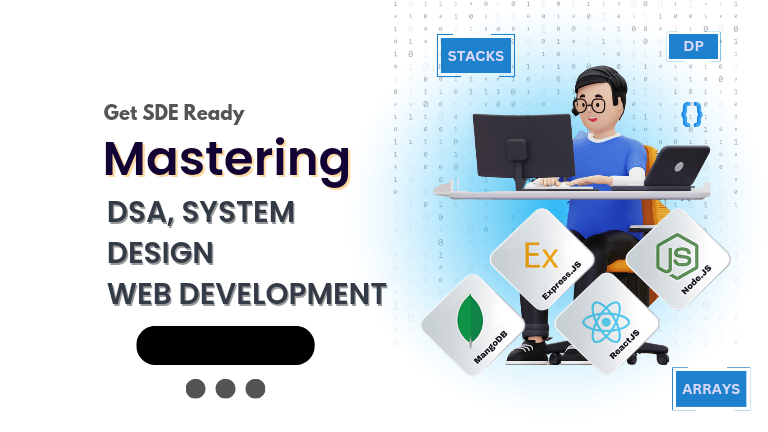
Fast-Track to Full Spectrum Software Engineering
- 120+ Live Classes & Recordings
- 24*7 Live Doubt Support
- 400+ DSA Practice Questions
- Comprehensive Notes
- HackerRank Tests & Quizzes
- 12+ live Projects & Deployments
- Case Studies
- Access to Global Peer Community
Buy for 51% OFF
₹35,000.00 ₹16,999.00
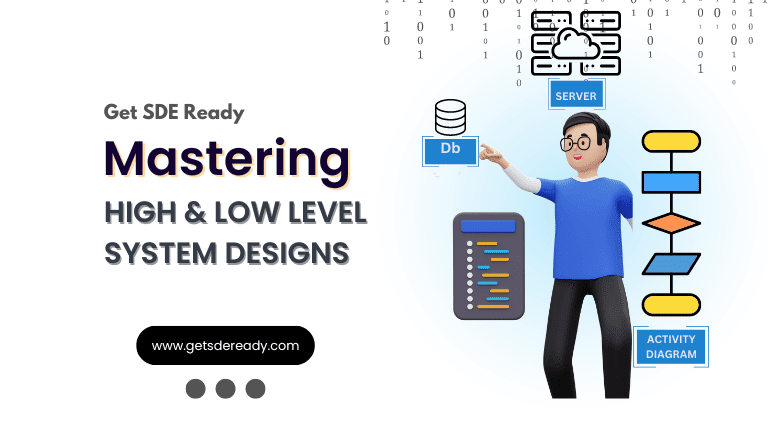
Low & High Level System Design
- 20+ Live Classes & Recordings
- 24*7 Live Doubt Support
- Case Studies
- Comprehensive Notes
- HackerRank Tests
- Topic-wise Quizzes
- Access to Global Peer Community
- Interview Prep Material
Buy for 60% OFF
₹20,000.00 ₹7,999.00

Mastering Mern Stack (WEB DEVELOPMENT)
- 65+ Live Classes & Recordings
- 24*7 Live Doubt Support
- 12+ Hands-on Live Projects & Deployments
- Comprehensive Notes & Quizzes
- Real-world Tools & Technologies
- Access to Global Peer Community
- Interview Prep Material
- Placement Assistance
Buy for 53% OFF
₹15,000.00 ₹6,999.00
Reach Out Now
If you have any queries, please fill out this form. We will surely reach out to you.
Contact Email
Reach us at the following email address.
arun@getsdeready.com
Phone Number
You can reach us by phone as well.
+91-97737 28034
Our Location
Rohini, Sector-3, Delhi-110085
